
Designing a country garden
for a rustic and natural style
Contents
Ah, the countryside! Who hasn’t wished to change their lives, reconnect with nature and the living world, and slow down the frantic pace imposed by cities? This idea has taken root firmly in the wake of the pandemic and the issues surrounding climate change. Recently, many city dwellers have chosen to move to the countryside, to give meaning to their lives, grow vegetables, and take the time to live… So here you are, perhaps among many new gardeners, happy owners of a garden in the countryside. And you are surely wondering how to design this garden, respecting nature, your own health, but also without becoming a slave to it. Choosing plants and following key principles, here are some tips for designing your country garden.
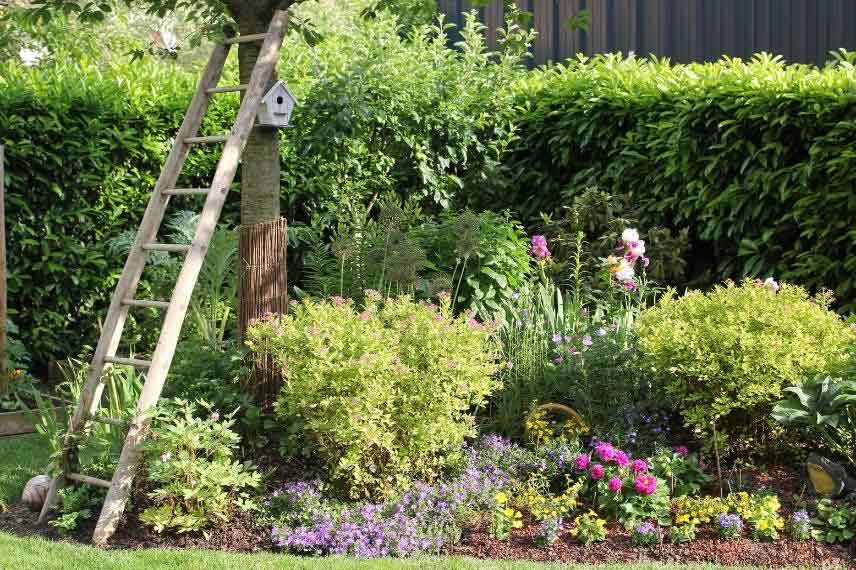 A little haven of peace, quite bucolic…
A little haven of peace, quite bucolic…
The countryside is multiple
Geographically, France may be the most diverse country in Europe. It is estimated that the French countryside changes approximately every thirty kilometres. The architecture changes, as do the types of gardens: large grassy areas bordered by ‘bocage’ hedges, old terraced fields partially collapsed, small enclosed and flat vicar’s gardens, or large hilly and wooded areas… therefore, there is not just one type of countryside garden, but several depending on:
- the terroir
- the local climate
- the type of soil
- the local flora
- the available materials
- the local practices
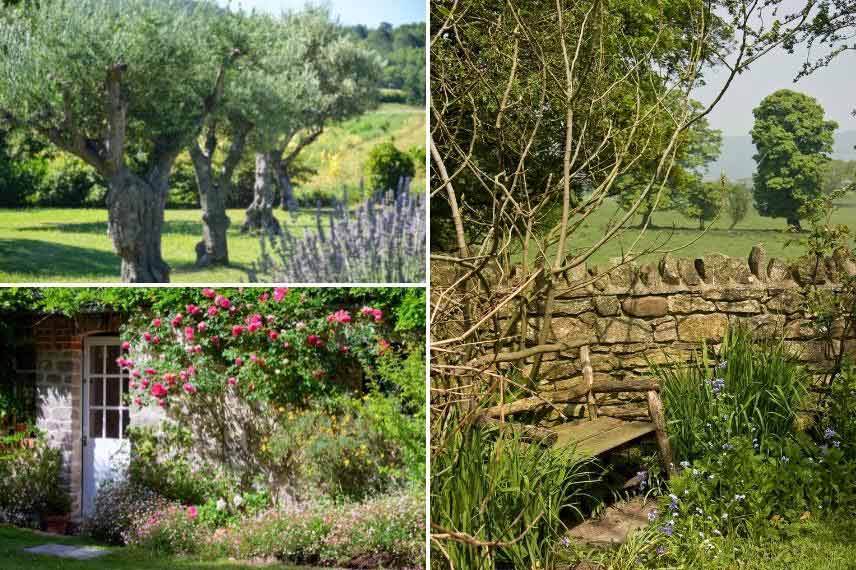
Your countryside garden will reflect the terroir in which it is set
When we talk about countryside gardens, inevitably linked to childhood memories and the good old days, we immediately think of our grandmother’s garden or the cottage gardens. They evoke a conception of the garden that is both very old and very trendy: grandmothers and vicars often had few resources and never wasted anything. Yet, their gardens nourished both body and spirit!
Thus, the countryside garden is:
- a garden adapted to the place
- a garden with a simple and local plant palette (so we will avoid planting palm trees in Aveyron or olive trees in Alsace…)
- it uses and reuses local resources sparingly and aims to be unostentatious
- it is productive, fruit-bearing, provides shelter and food for wildlife, and completely avoids chemical inputs
- finally, its simplicity allows the gardener who takes care of it jealously to take the time to live
Read also
Hedge for birds: which shrubs to choose?Which trees for my country garden?
To adorn your country garden, focus on local species. Adapted and resilient, these trees will form the foundation of your natural space. Start by assessing the existing trees and checking their condition. It may be necessary to carry out gentle pruning to remove dead wood and address any signs of disease. The planting distances should be defined based on the future growth of your trees and the desired effect: creating groves or planting specimens in isolation.
In a continental climate or even in mountainous areas, plant:
- Norway maple or Acer platanoides
- Downy birch or Betula pubescens
- Common hazel, Corylus avellana
- or Black alder, Alnus glutinosa
In the south or along the Atlantic coast, you can opt for slightly less hardy species, but also those more resistant to drought, especially for the Mediterranean region:
- Judas tree or Cercis siliquastrum
- Strawberry tree or Arbutus unedo
- Italian Alder or Alnus cordata
- Hop Hornbeam or Ostrya carpinifolia
- Holm oak or Quercus ilex
- and of course the essential olive tree of the south!
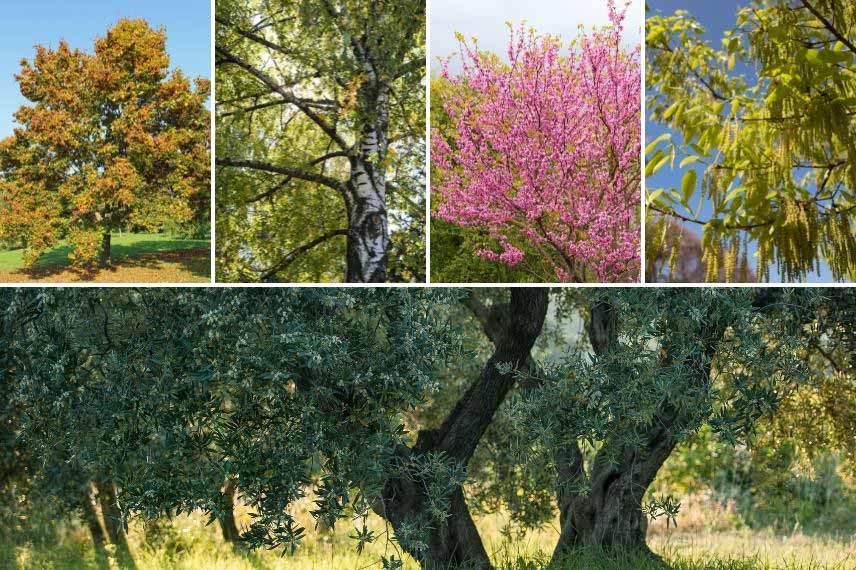
Acer platanoides, Betula, Cercis siliquastrum, Alnus cordata and Olea europea
Shrubs and hedge plants
In the south and along the Atlantic coast, create your hedges using easy-going bushes. Allow their natural habit to express itself by planting living hedges: Tamarisk, Russian Olive Elaeagnus angustifolia, Chalef (Eleagnus), Abelias… etc., should be planted at a distance that respects their development at ripeness to avoid excessive pruning. This should be kept to a minimum and aimed at encouraging your bushes to ramify.
Consider the essential oleanders (Nerium) which have the advantage of flowering easily and for a long time on evergreen foliage, as well as laurustinus (Viburnum tinus and Viburnum tinus ‘Variegatum’, with variegated foliage), which offer their white flowers in the heart of winter.
In continental climates and mountainous areas, you can plant to delineate your garden with a rustic or country effect:
- Hawthorn, Crataegus monogyna – Hawthorn
- Common Hornbeam, Carpinus betulus, for creating hornbeam hedges
- Purple Beech or Fagus sylvatica ‘Atropurpurea’
- Basket Willow or Salix viminalis
- Rowan or Sorbus aucuparia
- Butterfly Bushes (Buddleias)
- the Cornus or Dogwoods: with coloured wood or flowers
- Hollies (Ilex)
- and of course some bush roses, which you can choose according to your preferences.

Tamarisk, Abelia, Crataegus, Sorbus aucuparia and country hedge
Willow hedges also bring a charming touch to country gardens. To adopt them, follow our advice in the sheet: “How to plant and maintain a living willow hedge?
Perennials and climbing plants
Gardens in a mild, dry climate will thrive with the scents of lavenders, santolines, rosemaries, and helichrysums. Elsewhere, bushy sages will create very easy-to-grow flowering masses. However, be cautious; while some, like Salvia greggii ‘Alba’, are very hardy and can withstand winter temperatures down to -15°C, others, like the stunning Salvia involucrata ‘Bethelii’, which can form a dense bush nearly 1.5m tall in a season, will not survive below -5°C. Also consider Achilleas, with flowering umbels ranging from red to white, including orange and pink… they are easy, hardy, and robust! All vicar’s garden perennials and ornamental grasses are suited to these country gardens, giving you plenty of choices!
Don’t forget to sow wildflower seeds: poppies, cosmos, flax, or Nigella will create lovely bouquets and delight insects of all kinds!
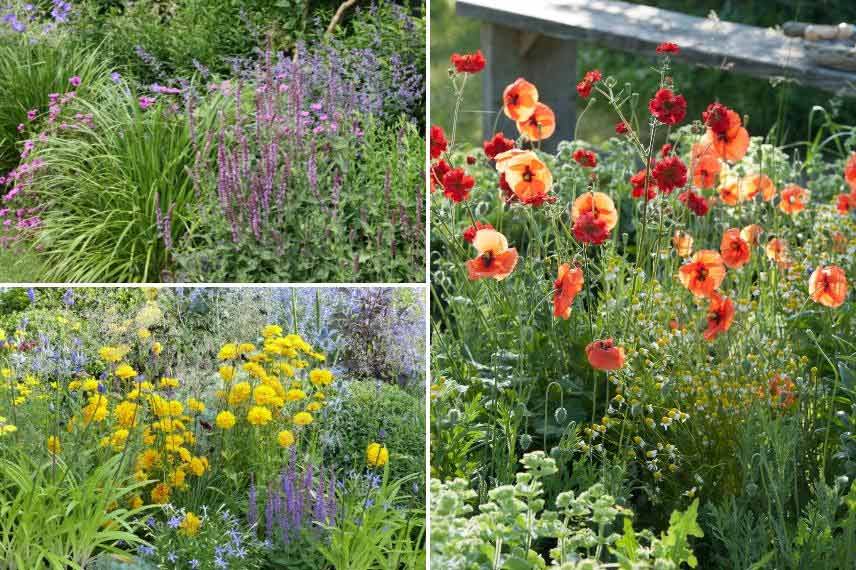
Perennials and annuals, ideal for country gardens
Dress your walls, pergola, or lovely wooden arches marking the paths of gravel walkways with climbing or trailing plants: honeysuckles with their sweet fragrance will quickly cover supports, wisterias will herald spring with their incomparable clusters, and climbing roses will delight both amateur and expert gardeners. In the south, trumpet vines will easily blend into the simple, natural look of a stone farmhouse alongside yellow (Rosa banksiae ‘Lutea’) or pink (Rosa banksiae ‘Rosea’) Banks roses. In colder regions, clematis will thrive on the pergola!
→ To ensure you plant appropriately, enter the characteristics of your garden or even each of your flowerbeds in our web application Plantfit!
The vegetable garden
A must-visit spot in the country garden: the vegetable garden. Surround it with small free hedges, if possible, made up of shrubs with small fruits (raspberries, blackcurrants, etc.). There’s no need to dive into intensive production, especially if you don’t have much time to dedicate. To start, stick to the “classics” (salads, tomatoes, courgettes, strawberries, etc.) and adjust your crops later based on your capabilities. Raised beds are a good alternative to in-ground vegetable gardens.

For your vegetable garden, check out the valuable advice in our dedicated articles:
Promote biodiversity and zero waste
In country gardens, we reconnect with a sense of moderation and simplicity, and we engage with the living world. Hedgerows or wildflower meadows and areas of flowering meadows promote biodiversity. Piles of wood provide a habitat for a variety of wildlife that thrives on finding shelter and food there. Create and install birdhouses to welcome birds and insect hotels.
Of course, all chemical products should be avoided: insecticides, pesticidal substances, chemical fertilisers… forget all that and practice natural gardening… nature will reward you!
In the same spirit, repurpose and upcycle everything you can: pallets can be transformed into benches or compost bins, terracotta pots into ollas, old zinc watering cans into flower pots, branches into barriers or playhouses for children… nothing is wasted, nothing is created, everything is transformed!

Repurposing allows for simple decoration and the creation of everything useful for the garden
- Subscribe!
- Contents
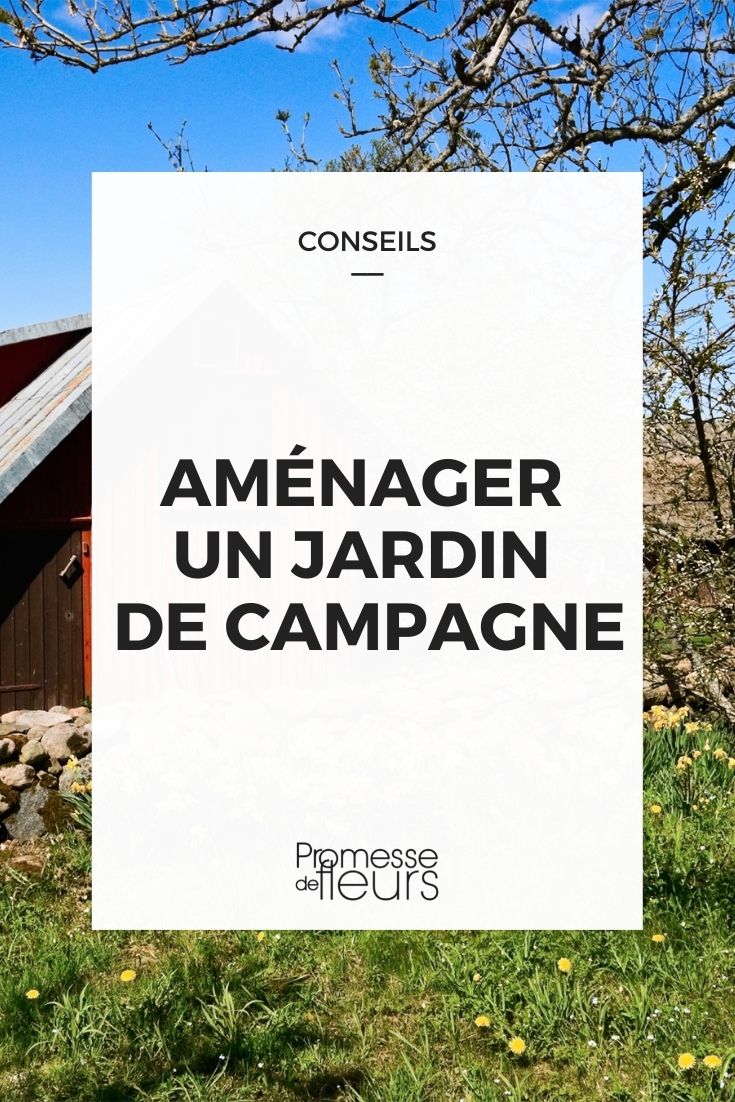































Comments